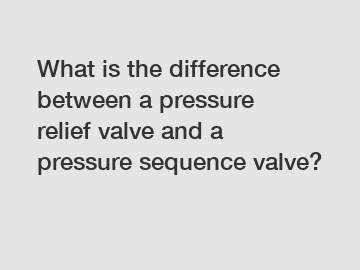What is the difference between a pressure relief valve and a pressure sequence valve?
What is the difference between a pressure relief valve and a pressure sequence valve?
Pressure relief valves and pressure sequence valves are two important components used in various hydraulic systems. While both valves are designed to manage pressure levels, they serve different purposes and operate differently. In this article, we will explore the key differences between pressure relief valves and pressure sequence valves, and how they contribute to the overall functioning of hydraulic systems.
Firstly, let's understand what each valve does and how it works:

1. Pressure Relief Valve:
A pressure relief valve, also known as a safety valve, is designed to protect hydraulic systems from excessive pressure. Its primary objective is to ensure that pressure remains within safe limits by diverting excess fluid flow back to the reservoir. When the pressure in a hydraulic system reaches a predetermined set point, the pressure relief valve opens momentarily, allowing fluid to bypass the circuit. This action safeguards the system from potential damage caused by overpressure situations.
Key points regarding pressure relief valves:
- Pressure relief valves are typically set to open at a specific pressure level, which can be adjusted as required.
- Upon reaching the set pressure, the valve opens and diverts the fluid to the reservoir, preventing damage to the hydraulic system.
- The pressure relief valve remains closed during normal system operation, only opening in case of excessive pressure.
- Once the pressure reduces to an acceptable level, the valve closes, allowing the fluid flow to return to the normal circuit.
2. Pressure Sequence Valve:
A pressure sequence valve, on the other hand, is designed to regulate the order of hydraulic system operations. It ensures that certain stages of a sequence are completed before allowing pressure to pass to the next stage. Pressure sequence valves are commonly used in systems where a specific sequence of operations is critical for optimal functioning, such as in machine tools.
Key points regarding pressure sequence valves:
- Pressure sequence valves allow pressure to pass through only when a predetermined pressure level is reached in the primary circuit.
- They are typically adjustable and can be set to specific pressure levels required for smooth operation.
- Pressure sequence valves play a crucial role in preventing premature operation of certain functions until the specified pressure is achieved.
- Once the pressure exceeds the set level, the valve opens, allowing the fluid to flow to the next stage in the sequence.
Now that we understand the basic differences between pressure relief valves and pressure sequence valves, let's summarize their distinctions:
1. Purpose:
- Pressure relief valves protect hydraulic systems from excessive pressure by diverting fluid flow back to the reservoir.
- Pressure sequence valves ensure the completion of certain sequential operations by allowing fluid flow to the next stage only when the predetermined pressure level is reached.
2. Operation:
- Pressure relief valves open momentarily when the pressure exceeds the set point, diverting the fluid flow to the reservoir until the pressure returns to a safe level.
- Pressure sequence valves open when a specific pressure level is reached, allowing the fluid flow to move forward to the next stage in the sequence.
3. Adjustable Setting:
- Pressure relief valves can be adjusted to open at different pressure levels as required by the system.
- Pressure sequence valves are also adjustable and allow the setting of specific pressure levels for optimal sequencing.
In conclusion, while both pressure relief valves and pressure sequence valves are vital components in hydraulic systems, they serve different purposes. Pressure relief valves protect the system from overpressure situations, whereas pressure sequence valves regulate the order of operations. Understanding these differences is crucial for the proper selection and functioning of hydraulic systems, ensuring safe and efficient operation.
If you want to learn more, please visit our website direct acting overflow valve supplier, wholesale Stacked hydraulic control check valve, wholesale hydraulic control check valve.


